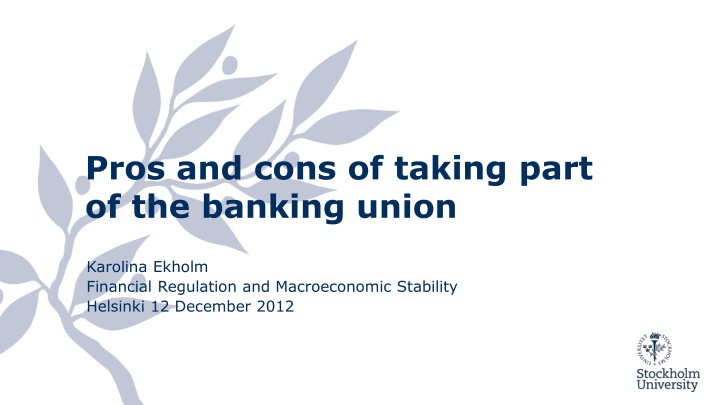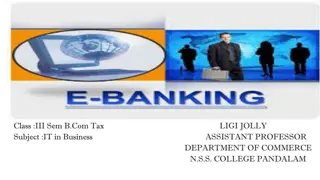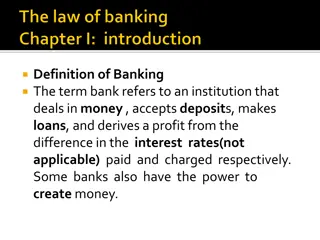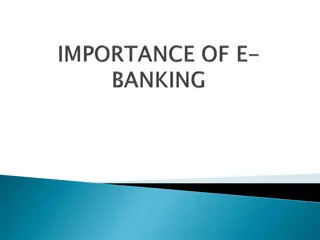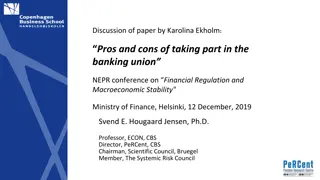Overview of European Banking Union: Pros and Cons
The European Banking Union comprises three pillars: Single Rule Book, Single Supervisory Mechanism (SSM), and Single Resolution Mechanism (SRM). The SSM, overseen by the ECB, supervises significant banks. Safeguards are in place for non-euro members. The SRM, managed by the SRB, aims at orderly resolution of banks through tools like bail-in. Non-euro members contribute to the common backstop for the SRM. The backstop for the SRM is provided by the ESM and is expected to be available by 2024.
Download Presentation

Please find below an Image/Link to download the presentation.
The content on the website is provided AS IS for your information and personal use only. It may not be sold, licensed, or shared on other websites without obtaining consent from the author.If you encounter any issues during the download, it is possible that the publisher has removed the file from their server.
You are allowed to download the files provided on this website for personal or commercial use, subject to the condition that they are used lawfully. All files are the property of their respective owners.
The content on the website is provided AS IS for your information and personal use only. It may not be sold, licensed, or shared on other websites without obtaining consent from the author.
E N D
Presentation Transcript
Pros and cons of taking part of the banking union Karolina Ekholm Financial Regulation and Macroeconomic Stability Helsinki 12 December 2012
The three pillars of the European banking union Common for all EU members: Single Rule Book SSM SRM EDIS CRDIV/CRR BRRD Single Supervisory Mechanism Single Resolution Mechanism European Desposit Insurance Scheme
The Single Supervisory Mechanism (SSM) The ECB is the direct supervisor of significant banks. 116 institutions covering more than 80 percent of total assets Ultimately responsible for all supervisory tasks Single Supervisory Board (SSB) consists of 25 voting members. Formal decisions are taken by governing council under a non-objection procedure.
Safeguards for potential non-euro members No objection from GC Everyone is happy Non-euro MS agrees Non euro MS can declare itself not bound by the decision. GC can then suspend or terminate its membership in the SSM. Objection by GC Draft decision by SRB GC upholds draft decision Non-euro MS can leave and declare itself unbound by the decsion Non-euro MS disagrees and notifies GC GC alters draft decision Non-euro MS happy
The Single Resolution Mechanism (SSM) Single Resolution Board (SRB) Single Resolution Fund (SRF) Responsible for resolution preparation and execution regarding significant banks and other cross-border groups. Resolution tools: sale of business bridge institution asset separation bail-in May be used to ensure orderly resolution of banks. Application of bail-in rules and principles laid down in BRRD a pre-condition. At least 8 % of total liabilities have to be bailed in. Built up by fees with target level of at least 1% of the amount of covered deposits by 2024. Successive mutualization of funds. Joining non-euro member have to transfer amount corresponding to what it would have paid if it had participated in the SSM and SRM at the outset. Leaving non-euro member should get its contributions back.
Back-stop for SRF Back-stop provided by ESM agreed in principle, but requires changes in the ESM treaty. Supposed to be available by 2024 at the latest. Should be fiscally neutral over the medium term Paid back with contributions from banks within three years (plus two if needed). Non-euro members are supposed to provide the common backstop together with the SRF, through parallel credit lines.
Legacy issues obstacle to progress on risk-sharing elements Non-performing loans ratios (percent of total amount of outstanding loans) in the banking union Q2 2019 45 40 35 30 25 20 15 10 5 0 Source: ECB
Potential benefits of membership in a banking union
Benefits related to externalities from dealing with distressed cross-border banks Liquidity problems and LOLR functions. Assessment of solvency may be based on better information. Financial stability Solvency problems and resolution. Financial trilemma , e.g. avoiding failure may benefit financial stability in many countries, but neither may individually have incentive to bear the cost of a bailout (Schoenmaker, 2011). National supervision Integrated financial markets Ringfencing leads to inefficient resolution with larger overall costs for taxpayers (e.g., Bolton and Oemke, 2019, on SPE vs. MPE strategies). How liquidity support in resolution would work is unclear.
Benefits related to externalities from distressed Sovereigns May weaken the doom-loop between banks and sovereigns in a monetary union. Motivation for centralized supervision in Farhi and Tirole (2018): Banks incentives to hold domestic debt higher in distress because the value of the put on taxpayer money through bailouts is higher. Sovereign has incentive to allow large concentrations because it shares the potential cost with other countries. For non-euro members, cross-border externalities of a sovereign default may be too small to make this argument valid.
Other potential benefits Better supervision Stronger influence
Potential costs of membership in a banking union
Costs associated with loss of control in a distressed situation Loss of regulatory and supervisory independence. Decision to declare a bank failing or likely to fail taken at ECB. Potentially poorer governance of resolution procedures. Bail-in and contagion risk. Bail-in of creditors is a channel of contagion. Creditors of low-risk banks are more likely to be bailed in inside the banking union.
Costs associated with mutualizing risk Increased exposure for taxpayers as long as risks are significantly higher in other members. Source: Communication from the Commission. Fourth Progress Report on the reduction of non- performing loans and further risk reduction in the Banking Union , 2019
Conclusion Uncertain benefits and costs. Expanding the banking union is likely to bring benefits in the form of more efficient resolution of cross-border banks. Whether it will also benefit the joining member depends on how those gains are distributed. Net benefits are smaller for non-euro members than for euro members. But overall costs for a joining non-euro country may be small because of the safeguards. Depends on how you view the political costs of leaving the banking union.
